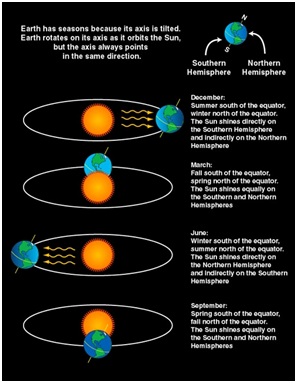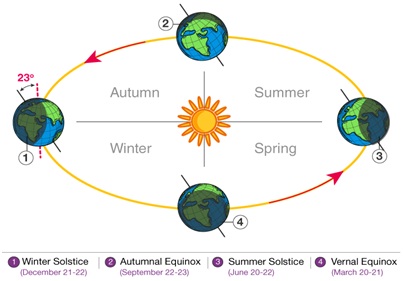

Context
On September 22, most of the Earth experienced about 12 hours of daylight and 12 hours of darkness. This is known as the Fall Equinox or the September Equinox.
What is an Equinox?
- Equinox is a point in a year when the daytime and night-time are approximate of equal lengths which are 12 hours each.
- The September equinox, also called the Autumnal equinox, marks the beginning of the
- astronomical fall season in the northern hemisphere
- astronomical spring in the southern hemisphere
- It is technically not a day-long astronomical event and being a day of equal daylight and night.
- This phenomenon occurs two times a year, usually on March 20th and September 22nd.
- During this time, the sun is exactly above the earth’s equator.
- Equator is an imaginary line on the middle of a planet or other celestial body.
- This results in the passing of the Terminator or Twilight Zone, which is a moving line that divides the illuminated side and the dark night side of the earth to pass through the earth’s north and south poles.
| Terminator |
| The terminator does not divide the planet into dark and light. The earth’s atmosphere bends sunlight by 37 miles (approximately 60 km), which equals half a degree. This suggests that one half of the earth is still more lit than the other part, even on the day of an equinox. |
- This unique angle causes all the areas of earth or other planets to experience almost the same amount of daylight and darkness twice every year.
- The two types of equinoxes that occur are March Equinox and September Equinox.
- In the northern hemisphere the March equinox is known as the vernal equinox (vernal means fresh or new like the spring), while in September, it is known as the autumnal equinox.
- The names are the opposite in the southern hemisphere because the seasons are switched. For example, autumn and the autumnal equinox occur in the southern hemisphere in March, when it is spring in the Northern Hemisphere.

What is the significance of this event?
- Marker of seasonal change: Like the solstices, equinoxes are the historical markers of seasonal change.
- The March equinox is regarded as the beginning of the spring season and is considered as the rebirth and renewal time. This is the reason why many cultures celebrate the March equinox as the first day of the new year.
- Comparatively, the September equinox marks fewer events generally associated with autumnal harvest festivals.
Correlation between the events of Solstice and Equinox:
- On Summer Solstice (June 21), when the Sun is at its highest path through the sky and the day is the longest, it starts to follow a lower and lower path in the sky every day until it is there for about 12 hours in a day. This point in the Sun's path occurs on September 22 and is called the Autumnal Equinox.
- It further continues to follow a lower and lower path through the sky (with the days getting shorter and shorter), the Sun reaches a point (called the Winter Solstice, occurring on December 21/22), after which it can't go any further lower.
- After the Winter Solstice, the sun starts following a higher and higher path through the sky until once again it is there for about 12 hours. This is the Vernal or Spring Equinox (March 21).
- The sun rises for the first time in the southern pole when the sun is lying directly above the equator on September 22nd. It also marks the beginning of the Midnight sun in which the sun never dips below the horizon. And at the north pole, it marks the beginning of Polar nights. Twilight will be there at the North pole, which will remain there until sometime in October before the sun disappears below the horizons.

Equinox Vs Solstice
Facts about Autumn Equinox:
- It is an instantaneous phenomenon and doesn’t last for the entire day.
- The day and night do not exactly last for 12 hours each.
- It does not occur on a fixed day, and usually, it occurs on September 22nd or 23rd.
- It is prime time to observe Northern lights (aurora borealis).
- The first full moon after the Autumnal equinox is called as Harvest Moon.
- Change of seasons around the world.
Effect of Equinox on the functioning of Satellites:
- Geostationary satellites have an equatorial orbit. Earth’s equator, as well as the earth’s poles, are tilted by 23.5°. This tilt also defines the limits of Tropic of Capricorn and Tropic of Cancer in the southern and northern hemispheres.
- Due to this tilt, the geostationary satellites orbits above or below the earth’s shadow and remain in sunlight continuously. But during equinox both the hemispheres get illuminated equally, resulting in the earth casting a shadow through the orbital path.
- This makes geostationary satellites to spend time in the shadow for a maximum of 72 minutes in each eclipse season, which lasts for 44 days.
- As the satellite depends on solar power to recharge its batteries, the depleted batteries and stringent thermal drop due to the absence of solar flux which also heats the satellites can disrupt the satellite functioning.
- Also, during the equinox, the background noise, provided by the Sun, blinds the reception (receiving the signals) on earth. This is known as Sun Outage in which the energy from the Sun disrupts the signal from a satellite.
Conclusion:
For a very long the ancient people have used the sky as a clock and calendar. They couldn’t have done this prior understanding about the periodic phenomenon like the Sun’s path across the sky, length of daylight, and location of sunrise and sunset all shifted regularly throughout the year. The event of the equinox is celebrated around the world suggesting its importance in different cultures. The Harvest Moon marks the beginning of the festive season in India. This full is also known as Bhadrapada Purnima in India and it marks the beginning of Pitrapaksha, the fortnight when the ancestors are remembered and worshipped.



